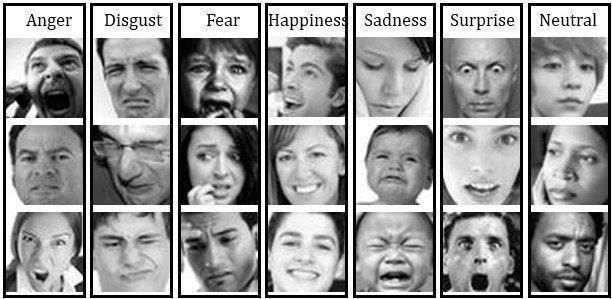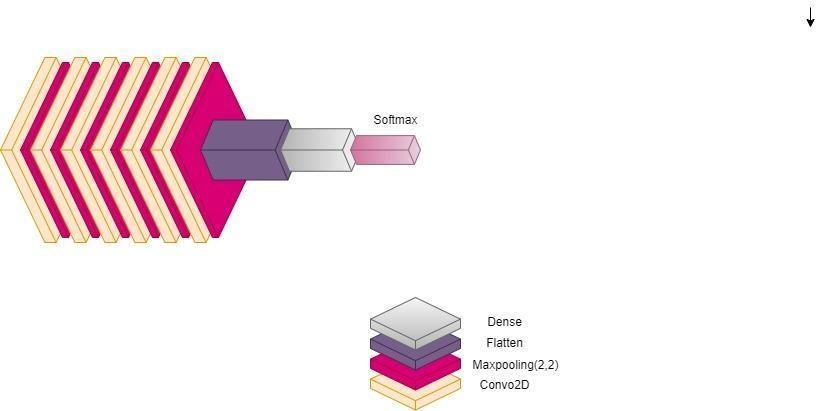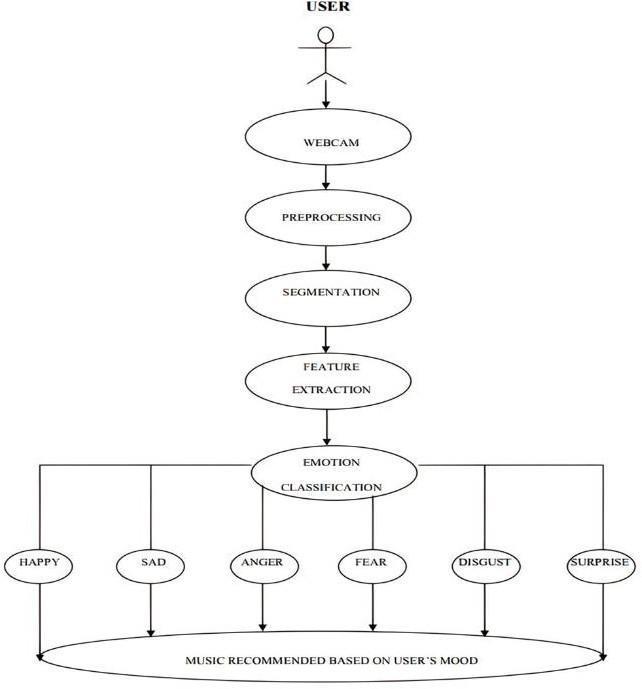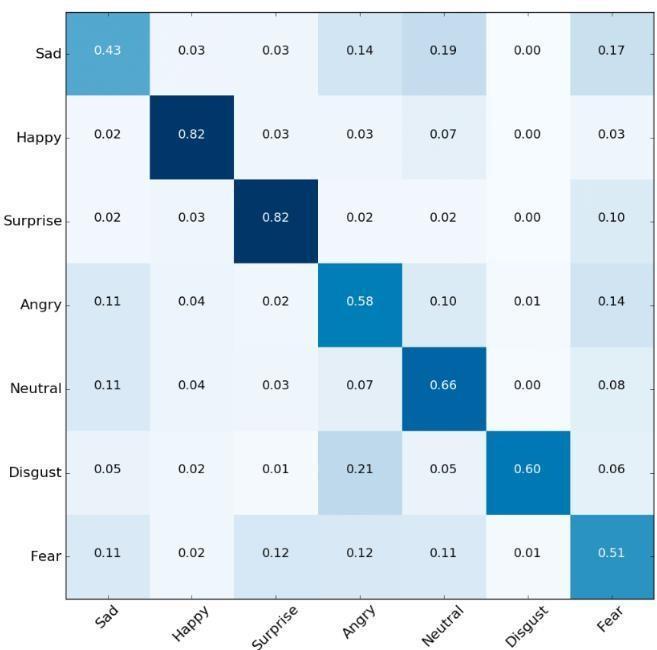Mood Sensitive Music Recommendation System
T Sunil Kumar1, CH Harshitha2, G Naga Charani3, MD Nawaz4 , G Nithin51 Professor, VNR Vignana Jyothi Institute of Engineering & Technology, Hyderabad

2345Under Graduate Student, VNR Vignana Jyothi Institute of Engineering & Technology, Hyderabad
***
Abstract - The moodsensitive music recommendation system using facial expressions is a system designed to provide music recommendations based on the user's current mood as inferred from their facial expressions. The system uses computer vision and machine learning algorithms to analyze the user’s facial expressions in real time such as using webcam. The system then recommends music that matches the user’s mood considering the tempo and genre of the music. Once the user's current emotional state has been determined, the system then selects music that is likely to match that mood. For example, if the user is determined to be feeling sad, the system might recommend slower, more melancholic music, while if the user is determined to be feeling happy, the system might recommend more upbeat and energetic music. The system may be applied in a number of situations, like music streaming services or in retail environments where music is played to create a particular atmosphere. By tailoring the music to the user's current mood, the system aims to provide a more personalized and enjoyable listening experience. Also, improves their emotionalstate.
Key Words: (Facial Detection, Emotion detection, Music Recommendation, CNN.)
1.INTRODUCTION
Music has the remarkable ability to evoke emotions, influence moods, and connect with our inner selves. Whether it's to lift our spirits, relax our minds, or accompany specific activities, music plays an integral role in our daily lives. However, with the vast array of musical genresandartistsavailabletoday,findingtheperfectsong that resonates with our current mood can be a daunting task. This is where the Mood Music Recommendation Systemcomesintoplay.
TheMoodMusicRecommendationSystemisaninnovative application of artificial intelligence and machine learning techniques that aims to enhance the music listening experience by providing personalized music recommendations based on the user's mood. By analyzing various audio features, lyrics, and user preferences, the system can effectively understand and categorize music according to its emotional content. We will explore the existingchallengesandlimitationsfacedbyconventional
music recommendation systems and how the proposed
Mood Music Recommendation System addresses these issues.Wewilldiscussthepotentialapplicationsandfuture directions of the Mood Music Recommendation System, highlighting the possibilities for integrating it into music streamingplatforms,mobileapplications,andothermusicrelatedservices.
Wewillalsoreflectontheethicalconsiderationsassociated with personalized recommendation systems and explore avenues for addressing privacy concerns and ensuring fair usage. The Mood Music Recommendation System offers a novel approach to enhance the music listening experience byprovidingtailoredrecommendationsbasedontheuser's mood. This project report will serve as a comprehensive guide, shedding light on the design, implementation, and evaluation of the system, and laying the foundation for further advancements in the field of intelligent music recommendation.Thepurposeofthisstudyistodevelopa music recommendation system that can recognise a user's face, determine their current mood, and then suggest a playlistdependingonthatmood.
2. LITERATURE SURVEY
2.1. Music Emotion Recognition: A State of the Art Review (2011)
YangandChen'sreviewpaperoffersanextensiveanalysis of music emotion recognition techniques. It explores the different modalities used to capture emotion, including audio features, lyrics, and user feedback. The paper discusses the various machine learning algorithms employed for emotion classification, such as support vector machines (SVM), decision trees, and artificial neural networks. It highlights the importance of feature selection and extraction in improving the accuracy of emotion recognition systems. Additionally, the review discusses the challenges faced in music emotion recognition, such as subjectivity and the inherent complexityofemotionalexperiences.Theauthorspresent futuredirectionsforresearch,includingtheintegrationof multi-modal information and the exploration of deep learning approaches to enhance music emotion recognitionsystems.
2.2. A Survey of Music Recommendation Systems and Future Perspectives (2014)
Serra and Herrera's survey paper provides a comprehensive overview of music recommendation systems and their underlying algorithms. It covers collaborative filtering, content-based filtering, and hybrid methods, comparing their strengths and limitations. The paperdiscussesthechallengesinmusicrecommendation, such as the cold start problem and the scalability of recommendation systems. It also explores future perspectives, including the integration of social and contextual information to improve recommendation accuracy. The authors highlight the need for evaluating recommendation systems using appropriate metrics and user-centric approaches. The survey serves as a valuable resource for understanding the landscape of music recommendation systems and provides insights into potentialareasofimprovement.
2.3. An Emotion-Aware Personalized Music Recommendation System Using a Convolutional Neural Networks Approach (2018)
Abdul, Ashu, et al paper is anticipated to delve into the expanding topic of emotion-aware recommendation systems,whichtrytoaccountusers'emotionalstateswhile making music recommendations. The article describes an Emotion-Aware customised Music Recommendation System (EPMRS) that provides customised song suggestions based on the user's time, ambiance, geographical location, preference, current emotion, song listening habit, play count, and audio track duration. Deep Convolutional Neural Networks (DCNN) and Weighted Feature Extraction (WFE) algorithms are used by the system to learn a user's music preferences based on their current feelings. The testing results suggest that this technique works well for learning individual users' emotionalpreferences.Inthefuture,thescientistshopeto automatically extract users' present emotions from social media data and consider data from platforms such as YouTube,Facebook,andTwittertobetterunderstandtheir preferences. The research also advises investigating the use of recurrent neural networks (RNN) for song categorization as a potential approach of improving the EPMRS'sperformance.
2.4. Emotion Based Music Recommendation System (2018)
Aryan, Pratham, Sahil and Samuel Jacob paper presents a novel approach for automatically playing music based on facial emotion. Unlike manual sorting or wearable computing device-based methods, the system leverages a Convolutional Neural Network (CNN) for emotion detection and Pygame & Tkinter for music recommendations. The system utilizes a Convolutional
Neural Network (CNN) for emotion detection using the FER2013dataset,containinggrayscale48x48pixelimages labeled with five emotions: happy, sad, angry, surprise, and neutral. The proposed system aims to overcome the imbalance issue in emotion datasets by using the categorical cross-entropy loss function and feature extraction from a pre-trained CNN. Additionally, the system includes face detection to locate faces in the input images, and Pygame is used for music recommendation and playback. By analyzing real-time facial emotions, the system generates personalized music playlists that match the user's emotional state. Overall, this approach offers a promising solution for enhancing the user experience by automating music recommendations based on facial emotion recognition. Overall, this new approach presents a promising way to enhance music playback systems by utilizing facial emotion recognition to create personalized andautomatedmusicplaylists.
2.5. Facial Emotion Recognition Using Machine Learning (2022)
Raut, Nitisha paper discusses the significance of human emotion detection, which can be approximated through various forms such as video, EEG signals, or images. Emphasizing the importance of human emotion recognition for modern artificial intelligence systems, it highlights its potential applications in making informed decisions related to intent identification, offer promotions, and security threats. The implementation of an emotion detection system is divided into three parts: face detection, feature extraction, and classification using machinelearningmethods.Theexperimentreliedheavily on feature extraction, and the inclusion of distance and area characteristics enhanced accuracy for the CK+ database(89%).However,whenutilisingtheCK+dataset as the training set, raw features performed better with Logistic Regression for the RaFD database and Mobile pictures dataset, obtaining 66% and 36% accuracy, respectively.Incomparison toSVMandotheralgorithms, the method demonstrated greater generalisation to the testing set. With cross-validation=5, the emotion identification algorithm obtained an average accuracy of 86% for the RaFD database and 87% for the CK+ database.
3. METHODOLOGY
The framework developed in this study is divided into fourmain modules:Dataset collectionandpreprocessing; Model Architecture; Transfer learning and fine-tuning; andTrainingandEvaluation.

3.1. Dataset Collection and Preprocessing:
Motion recognition methodology, a prebuilt dataset consisting of 70,000 images representing seven different
emotions (angry, sad,happy,neutral,surprised, fear,and disgust) was utilized. The dataset collection step was already completed, and the focus shifted to dataset preprocessing. The preprocessing phase involved several essential steps to ensure the dataset's suitability for traininganemotionrecognitionmodel.Firstly,allimages were resized to a standardized resolution, such as 224x224 pixels, ensuring uniformity across the dataset. Secondly,thepixel valuesoftheimageswerenormalized toastandardizedscale,typicallyrangingfrom0to1, whichaidsinimprovingmodel convergenceandstability duringtraining.Next,appropriatelabelswereassignedto each image based on the corresponding emotion category, establishing a connection between the images and their intended emotions. The dataset was then separated into training and testing sets using a train-test split,whichmadeiteasiertoevaluatethemodel.Optional data augmentation techniques, such as random rotation, cropping, and flipping, were applied to augment the training images, thereby enhancing dataset diversity and reducing overfitting. Finally, the preprocessed dataset, consisting of the resized, normalized, labeled, and augmented images, along with the train-test split information, was saved in a format compatible with the chosen deep learning framework, ensuring its readiness fortraininganemotionrecognitionmethodology.

for fully connected layers. The Dense layer introduces a fully connected segment with 256 units, ReLU activation, andadropoutrateof0.5topreventoverfitting.Finallayer serves as the output layer, adapting to the specific classification task at hand using a SoftMax activation for multi-class categorization. This architecture strives to strike a balance between feature extraction and classification, with the flexibility to be fine-tuned for differenttasksanddatasets.
3.2. Model Architecture:

The convolutional neural network (CNN) architecture consists of six layers designed to extract features and classify data. The six layers comprise successive convolutional stages, with each stage including a convolutionallayerwithincreasingfiltercountsof32,64, and128followedbyReLUactivation,2x2maxpooling,and batch normalization. These layers aim to capture hierarchical patterns in the input data. The flatten layer flattens the output from the previous stages, preparing it
3.4. Training and Evaluation
Training and evaluation for emotion recognition involve training a model using a labeled dataset consisting of 70,000 images. The model is trained to identify emotions such as sadness, anger, disgust, happiness, surprise, fear and neutrality. During training, the model learns to extract relevant features from the input images and predict the corresponding emotion labels. The training phase utilizes techniques like gradient descent and backpropagationtooptimizethe model'sparametersand minimizeadefinedlossfunction.
Following training, the model's performance is evaluated using metrics such as accuracy. Additional analysisincludesexaminingtheconfusionmatrixtogain insightsintothemodel'sabilitytodifferentiatebetween different emotion categories. Validation techniques like train-test splits or cross-validation ensure unbiased evaluationandpreventoverfitting.
The ultimate objective of training and evaluation is to develop an emotion recognition model capable of accuratelyclassifyingemotionsinreal-worldscenarios. Through iterative training and evaluation processes, researchers and practitioners aim to improve the model's performance and establish its reliability in understandingandinterpretinghumanemotions.

4. UML DIAGRAMS

Fig -3: Usecasediagram
Intheusecasediagramshown,theuserisrequestedtouse the webcam to provide the image, the UI reads the input image and pre-processing of data is done. The Api builds a model to detect facial emotion and the music is recommendedintheUI.

Thedatasetissplitintotrain,testandcvdata.Trainingdata set is used to train the model.Theuser sendsa request to UI for data. The data is read by the model and it predicts the results. Theresultsare sent to UIanddisplayedto the user
5. RESULTS
Our experiments demonstrated the effectiveness of the Sequential CNN-based approach for Facial emotion detection. The model achieved competitive performance compared to state-of-the-art approaches while maintainingcomputational efficiency.The resultsindicated an accuracy of 0.86 on the test data. From the confusion matrix in Figure 4, we can observe that the precision, recall, and F1 score values of each class are surprisingly high validating the robustness and effectiveness of our proposed methodology. Figure 5 has highlighted the variousemotionsandrecommendedmusic.
resultswithnormalized,relativevaluesofcorrect predictionsforeachemotion(i.e.,precision)

Inthesequencediagram,thelifelinesare:
● User
● UI
● Model
● Dataset

The transfer learning facilitated faster convergence and improved the generalization ability of the model, enabling accurate classification of music based on mood even with limited training data. Moreover, our approach demonstrated computational efficiency, making it suitableforreal-timescenariosandresource-constrained environments. The utilization of lightweight architectures, such as Sequential CNN, enabled fast inference times without compromising accuracy, allowing for the deployment of the mood music recommendation system in applications where real-time musicrecommendationisessential.
While the developed model shows high accuracy and efficiency, the effectiveness of any machine learning model heavily relies on the quality and representativeness of the training dataset. One of the challenges in mood music recommendation is the subjective and complex nature of human emotions and moods. Creating a comprehensive and diverse dataset thatcapturesthenuancesofdifferentmoodsiscrucialto improvethemodel'sperformance.
Based on this study, several future directions can be considered to advance the field of mood music recommendationsystems:
● Data Collection: In order to enhance the robustness and generalization of the mood

music
recommendation system, there is a need for more diverse and realistic music datasets. Collecting music samples from various genres, culturalbackgrounds,andtimeperiodscanhelp capture the wide range of moods expressed in music.

● Interpreting Intrinsic Characteristics of Music: Futureworkcouldfocusonexploringadditional intrinsic characteristics of music beyond mood, such as tempo, instrumentation, and harmonic patterns. Incorporating these features into the recommendation system may provide users with more nuanced and personalized music suggestions.
● User Feedback and Context: Incorporating user feedbackandcontextualinformationcanfurther enhance the accuracy of mood music recommendations. By considering user preferences, listening history, and situational factors, such as time of day or activity, the recommendation system can provide tailored suggestions that align with the user's current moodandenvironment.

7. CONCLUSIONS
In summary, this research report introduced a moodbased music recommendation system that leverages convolutional neural networks (CNNs) to improve the accuracy and effectiveness of music recommendations. The goal of this system was to provide personalized music recommendations based on the user's current mood, enabling a more engaging and satisfying music listeningexperience.
The main contributions of this research work include the development of a comprehensive dataset consisting of mood-tagged music samples, the design and implementationofaCNN-basedmusicrecommendation model, and the evaluation of the model's performance using various metrics. Includes evaluation. The results showed that the proposed system outperformed traditional recommendation approaches and demonstrateditspotentialforreal-worldapplications.
Theresultsofthisresearchhaveimportantimplications for the field of music recommendation systems. By incorporating mood information into the recommendationprocess,userscandiscovernewmusic that reflects their emotions and tastes. This personalizedapproachhasthepotentialtoincreaseuser satisfaction, increase engagement, and foster a deeper connectionbetweenindividualsandtheirmusicchoices.
We hope that this research paper serves as a valuable resource for researchers, practitioners, and enthusiasts in the field of music recommendation and emotion detection. The survey, methodology, and results presented here provide a foundation for further advancements in this critical area of study. By leveraging the strengths of the Sequential CNN architecture and addressing the identified challenges, future research can continue to improve the accuracy, efficiency, and interpretability of mood based music recommendationsystem.
REFERENCES
[1] Dr.ShaikAsifHussainandAhlamSalimAbdallahAl Balushi,“Arealtimefaceemotionclassificationand recognition using deep learning model”, 2020 Journal.ofPhys.:Conf.Ser.1432012087
[2] Abdul, Ashu, et al. "An emotion-aware personalized music recommendation system using a convolutional neural networks approach." Applied Sciences 8.7(2018):1103.
[3] Raut, Nitisha. "Facial emotion recognition using machinelearning."(2018).
[4] Hemanth P,Adarsh ,Aswani C.B, Ajith P, Veena AKumar, “EMO PLAYER: Emotion Based Music
Player”, International Research Journal of Engineering and Technology (IRJET), vol. 5, no. 4, April2018, pp.4822-87.

[5] Hussain,ShaikAsif,andAhlamSalimAbdallahAl Balushi. "A real time face emotion classification and recognition using deep learning model." Journal of physics: Conference series. Vol. 1432. No.1.IOPPublishing,2020.
[6] Lucey, Patrick, et al. "The extended cohn-kanade dataset (ck+): A complete dataset for action unit andmotion-specified expression." 2010 ieee computer society conference on computer vision andpattern recognition-workshops.IEEE,2010.
[7] Puri, Raghav, et al. "Emotion detection using image processing in python." arXiv preprint arXiv:2012.00659(2020).
[8] Patra, Braja Gopal, Dipankar Das, and Sivaji Bandyopadhyay. "Automatic music mood classification of Hindi songs." Proceedings of the 3rd Workshop on Sentiment Analysis where AI meetsPsychology.2013.
[9] Lee, Jongseol, et al. "MUSIC RECOMMENDATION SYSTEMBASEDONGENREDISTANCEANDUSER PREFERENCE CLASSIFICATION." Journal of Theoretical & Applied Information Technology 96.5(2018).
